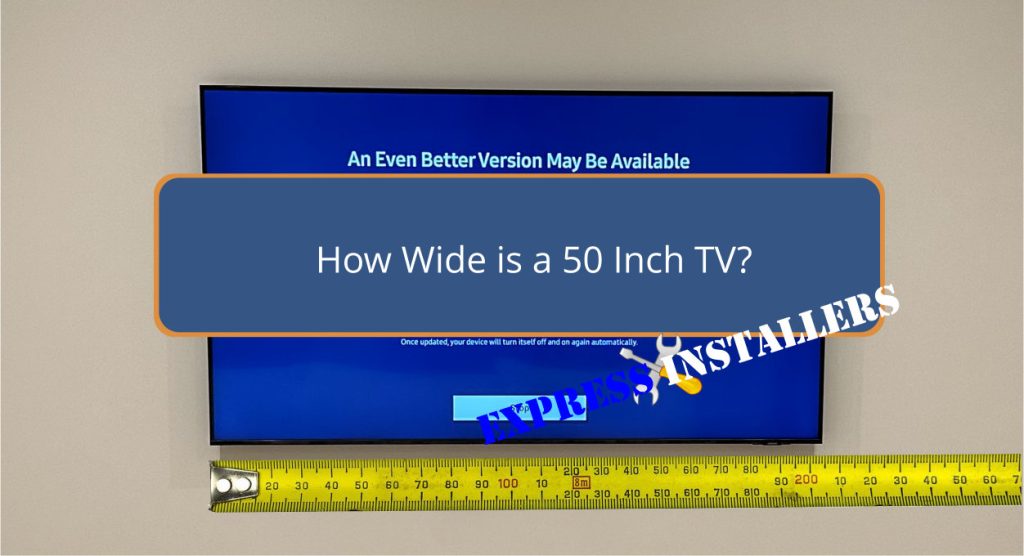
So, how wide is a 50 Inch TV? When measuring the width of a 50-inch TV, focus on the distance between the outermost left and right edges on the same side: Top to top or bottom to bottom.
Typically, a 50-inch TV is about 43.8 inches wide. This dimension guarantees compatibility with stands, mounts, and your living space setup.
Make sure your measurements are precise to effectively manage aesthetics, ventilation, and functionality. Manufacturer’s specifications are indispensable for exact dimensions.
Consider ergonomics by evaluating height placement, viewing angle, and cable management. To optimise your TV setup further, consider factors like display technology, refresh rate, and smart features.
When understanding TV sizes, it’s important to remember that a 50-inch measurement refers to the diagonal length of the screen, not the width. While this diagonal metric is standard, it can be somewhat misleading when trying to assess actual spatial requirements.
The width of a 50-inch TV, typically around 43.8 inches, is critical when configuring your entertainment setup. Variations can occur due to different model specifications and bezel designs. Always prioritise the screen width over the Diagonal dimension for accurate fitting in your designated area.
This precise width knowledge guarantees compatibility with TV stands or wall mounts, facilitating optimal installation and viewing angles. Considering these dimensions allows you to manage your living space effectively for an enhanced viewing experience.
Measuring a TV’s width involves determining the distance between the screen’s outermost left and right edges, which guarantees a perfect fit in your entertainment setup.
For a 50-inch TV, the width typically ranges from 43-44 inches, though exact dimensions can vary by brand and model. To obtain precise measurements, please consult the manufacturer’s specifications.
This measurement is vital when planning for what size TV stand for a 50 Inch TV, wall mount, or within an entertainment centre. Accurately gauging the TV’s width ensures it fits seamlessly into your designated space, aligning with your room’s layout.
Always consider this dimension to avoid any spatial discrepancies that could affect your viewing area’s aesthetics and functionality.
For ideal viewing distance, industry experts suggest sitting approximately 6.25 feet from a 50-inch TV to guarantee a balanced and immersive visual experience. This distance is calculated based on the screen’s diagonal measurement and typical eye resolution, securing a pixel density that aligns with peak human visual acuity.
At 6.25 feet, the field of view encompasses around 30 degrees, minimising eye strain while maximising image clarity. Such meticulous calibration guarantees that motion blur and pixelation are imperceptible, enhancing your content consumption.
To optimise your entertainment setup, consider the precise width of a 50-inch TV, typically around 43.8 inches, ensuring it fits seamlessly within your designated space. When planning your layout, account for the bezel dimensions and potential variances in model design.
Measure your media console or wall space meticulously to comfortably accommodate the TV’s width, factoring in electronic components’ ventilation requirements. Utilise a VESA-compatible wall mount if opting for a mounted solution, ensuring it supports the TV’s dimensions and weight.
Evaluate your setup’s ergonomics by gauging the viewing angle and TV height placement. Proper cable management is essential to maintaining a clean, organised appearance. Tailoring these considerations to your specific environment will enhance functionality and aesthetics.
Beyond just the dimensions, evaluate the display technology, refresh rate, and smart features of a 50-inch TV to confirm it aligns with your viewing preferences and connectivity requirements.
Consider OLED versus LED; OLED offers superior contrast ratios and deeper blacks, enhancing visual fidelity. Assess the refresh rate, aiming for at least 120Hz for smooth motion, particularly for gaming or sports.
Connectivity is paramount—ensure the TV supports HDMI 2.1 for future-proofing and low-latency gaming. Integrated smart features, such as built-in streaming services and voice control, enhance user experience and reduce the need for additional devices.
Pay attention to HDR support, which provides a broader colour spectrum and improved brightness, delivering a more immersive viewing experience.
A 50-inch TV generally measures about 43.8 inches in width. However, this dimension can vary depending on the brand and model, necessitating precise measurements for accurate wall mounting and stand selection.
For a 50-inch TV, the screen width is approximately 127 centimetres. However, model variations mean the actual width typically ranges from 109 to 114 centimetres. Always measure the screen width, excluding the bezel, for precise placement.
For a 50-inch TV, allocate at least 44 inches in width. Consider additional space for bezel dimensions and ventilation. Guarantee your stand or wall space supports the TV’s overall measurements to maintain peak performance and aesthetic balance.
For a 50-inch TV, you should choose a TV stand that’s 44-46 inches wide. This guarantees ideal load distribution and stability and prevents tipping. Factor in adjustable shelves or drawers for enhanced storage and media device accommodation.
In essence, precise measurements are essential when planning to integrate a 50-inch TV into your setup. By understanding diagonal screen size, aspect ratios, and ideal viewing distances, you’ll guarantee a seamless fit in your space.
Don’t overlook additional factors like bezel width and mounting options. Leveraging these insights, you’ll achieve an ideal viewing experience and maintain aesthetic harmony in your environment, enhancing functionality and visual appeal.
Mon-Fri: 24 Hours
Sat: 24 Hours
Sun: 24 Hours